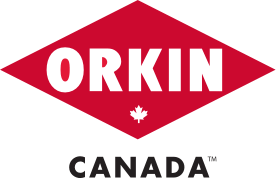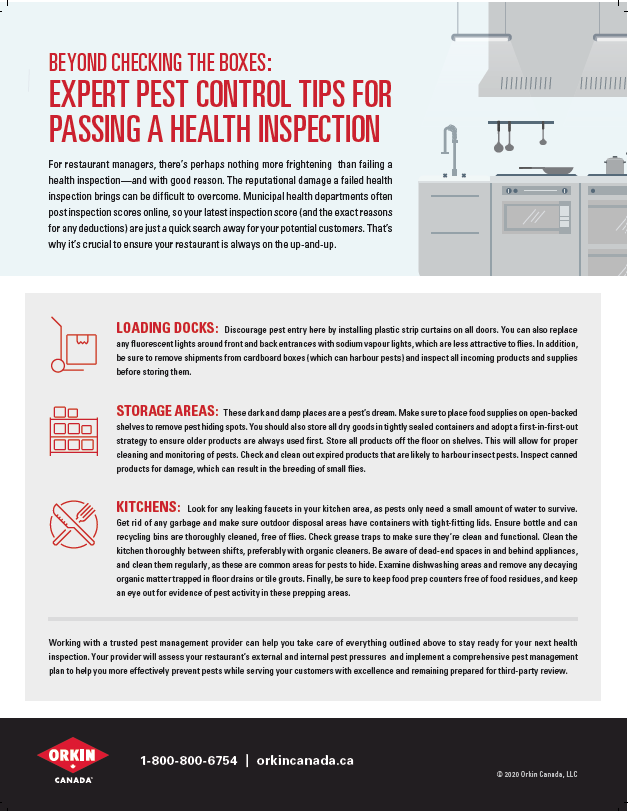For restaurant managers, there’s perhaps nothing more frightening than failing a health inspection—and with good reason. The reputational damage a failed health inspection brings can be difficult to overcome. Municipal health departments often post inspection scores online, so your latest inspection score (and the exact reasons for any deductions) are just a quick search away for your potential customers. That’s why it’s crucial to ensure your restaurant is always on the up-and-up.
Loading Docks
Discourage pest entry here by installing plastic strip curtains on all doors. You can also replace any fluorescent lights around front and back entrances with sodium vapour lights, which are less attractive to flies. In addition, be sure to remove shipments from cardboard boxes (which can harbour pests) and inspect all incoming products and supplies before storing them.
Storage areas
These dark and damp places are a pest’s dream. Make sure to place food supplies on open-backed shelves to remove pest hiding spots. You should also store all dry goods in tightly sealed containers and adopt a first-in-first-out strategy to ensure older products are always used first.
Store all products off the floor on shelves. This will allow for proper cleaning and monitoring of pests. Check and clean out expired products that are likely to harbour insect pests. Inspect canned products for damage, which can result in the breeding of small flies.
Kitchens
Look for any leaking faucets in your kitchen area, as pests only need a small amount of water to survive. Get rid of any garbage and make sure outdoor disposal areas have containers with tight-fitting lids. Ensure bottle and can recycling bins are thoroughly cleaned, free of flies. Check grease traps to make sure they’re clean and functional. Clean the kitchen thoroughly between shifts, preferably with organic cleaners.
Be aware of dead-end spaces in and behind appliances, and clean them regularly, as these are common areas for pests to hide. Examine dishwashing areas and remove any decaying organic matter trapped in floor drains or tile grouts. Finally, be sure to keep food prep counters free of food residues, and keep an eye out for evidence of pest activity in these prepping areas.
Working with a trusted pest management provider can help you take care of everything outlined above to stay ready for your next health inspection. Your provider will assess your restaurant’s external and internal pest pressures and implement a comprehensive pest management plan to help you more effectively prevent pests while serving your customers with excellence and remaining prepared for third-party review.
Need a quick reference guide for all of this? You can also download our expert tip sheet here.

You may also like
Canada's Top 25 Bed Bug Cities Of 2023
Bed bugs are extremely efficient hitch hikers. They can move easily across a room and climb onto luggage or anything left on a bed in just one night. Learn which cities have made Canada’s top 25 bed buggiest cities.
British Columbia's Top 20 'Rattiest' Cities 2023
As winter approaches, pest control leader Orkin Canada reminds homeowners and business owners to take precautions to help keep rodents out. Cities are ranked by the number of rodent (rat & mice) treatments the company performed from August 1, 2021 through July 31, 2022.
Ontario's Top 25 "Rattiest" Cities 2023
Pest control leader Orkin Canada reminds home owners and business owners to take precautions to help keep rodents out. Cities are ranked by the number of rodent (rat & mice) treatments the company performed from August 1, 2022 through July 31, 2023. This ranking includes both residential and commercial treatments.
Eastern Canada's Top 15 'Rattiest' Cities 2023
As winter approaches, pest control leader Orkin Canada reminds homeowners and business owners to take precautions to help keep rodents out. Cities are ranked by the number of rodent (rat & mice) treatments the company performed from August 1, 2021 through July 31, 2022.
Remove pests from your business, and stop them from coming back
We work hard to listen, understand and assess your unique situation. Request a free, no-obligation consultation today for a customized pest program that fits your needs.
Request a Free Business ConsultationRequest a Free Home Estimate


